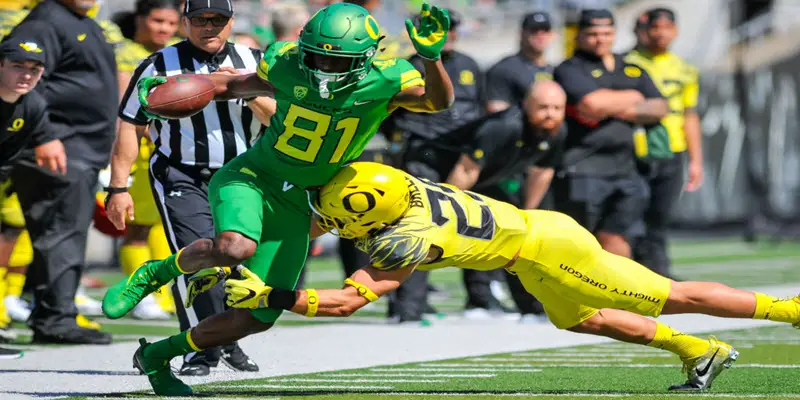Spring football games are usually yawners, but Oregon’s annual rite was interesting in many places and actually exciting in others. Heisman candidate quarterback Justin Herbert was not at his best, but was impressive at times: throwing accurate strikes on deep sideline and hook routes, but missing a couple of deep balls that need to be completed in the fall if the Ducks are going to make a move in the Northern Division of the Pac-12.
Coach Mario Cristobal had to be pleased with the overall effort of the offense and defense that were matched up in more of a scrimmage situation than splitting into teams as the number of healthy bodies limited that option. A good crowd of 27,317 lounged in the sunshine and went home with high hopes for this fall. Some questions were answered and some were not. Spring is too short a season to find a solution to all the challenges the Ducks left on the table after the Las Vegas Bowl debacle. One thing for sure, “try and play better so you don’t have to settle for that bowl game,” as Vegas has featured some of the worst football Oregon has played in the modern era.
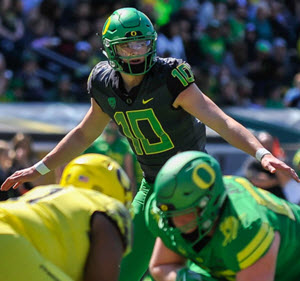
Justin Herbert
As expected, Justin Herbert lead the quarterbacks’ passing, completing 12-of-21 for 126 yards and a touchdown with one interception which was returned for a touchdown. Herbert was not his usual self: low in completion percentage (57%) and missing several longer throws that could have gone for scores; one under-thrown and another overthrown. He showed excellent speed on the frequent times he was forced to run when receivers couldn’t get open or the pass protection broke down.
Best personnel change: Hunter Kampmoyer, former defensive lineman at 6-4, 262, was moved to tight end and has brought a strong physical presence to an offensive line Cristobal is trying to conform to Southeast Conference standards. The Duck’s tight ends have been hit or miss the past couple of years and Kampmoyer’s presence has put the position in a very positive light. He has some work to do to in reading defenses, particularly zone coverage, where you have to learn to recognize an open area, stop and square up with the quarterback (which he didn’t do on a pass from Braxton Burmeister). Kampmoyer has good hands and can catch the ball, and should improve rapidly; giving the Ducks several good tight ends along with Jacob Breeland and Cam McCormick, both of whom still need to be more physical blockers, especially in short yardage situations.
Biggest liability: The Ducks only have three true quarterbacks on scholarship, plus a walk-on. Fans still can’t forget the frustration last season when Herbert was injured and missed several games; the offense sputtering as Justin sat on the bench. Back then, there didn’t seem to be much of an effort to build Braxton Burmeister’s confidence with play calling or formation strategies as he struggled to fill Herbert’s shoes.
Willie Taggart’s biggest mistake was to not take Burmeister off the redshirt list when quarterbacks Jonson and Wilson left the program in the summer before last season, leaving only Herbert, perennial backup Taylor Allie and Burmeister, who did not get any meaningful reps during fall camp. It was insane to think you would get through the whole season without injury to the quarterback position. No matter what was thought of Burmeister’s potential, it should have been a goal to make him believe he was the best quarterback on the planet, just so he’d be better if he had to play.
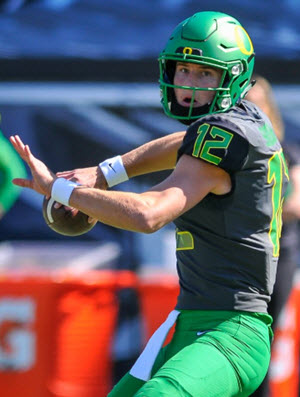
Tyler Shough
Burmeister has improved, but he still makes mistakes, which is not unusual, since he should be a redshirt freshman instead of a true sophomore. He threw a nice touchdown pass, splitting a safety and corner and had a couple of other strong throws. He threw at least two poor slant passes, but the receivers running the route did not do anything to get open. I would suggest getting out the Boise State offensive film and watching their short yardage passing game, both by formation and the completely legal “rub routes” their receivers run to shake press coverage.
Cristobal is going to spend most of his time with the offensive line, which is unusual for a head coach, but it is a good idea because the offensive line has got to protect Herbert like the franchise that he is. Tyler Shough, a true freshman just out of high school this past fall, threw for two scores and showed off a strong arm, nice touch and good pocket presence. If Herbert went down, Shough would probably get the call because he’s a better, more disciplined passer. Burmeister would not be out of the running as he has come a long way and he is by far the best option quarterback. But the Ducks should have five scholarship quarterbacks to get through a rugged Pac-12 season. Walk on Mike Irwin gives some depth at the position, but like Allie, seems limited by Pac-12 standards.
Play calling heebie jeebies-Willie Taggart was a conservative play caller and when he left for Florida State before the Las Vegas Bowl, there was some excitement that maybe things would change because offensive coordinator Marcus Arroyo was tapped by Cristobal to call the plays. It is not clear if that’s what actually happened as the plays were going through the head coach’s headset. If anything, for the first two-thirds of the game, the play selections were worse: without Royce Freeman, the running game was left up to backs who were timid and it seemed forgotten that the Ducks had a Heisman-like quarterback handing off for a lot of two-yard gains. It was no surprise that Oregon didn’t cross midfield until there were six minutes left in the third quarter, a truly pathetic performance by both players and coaches.
Judging by practice and the spring game, it seems like those frustrations of the past may be over; the Ducks seemed fairly wide open with play selections and it looks like there will be an effort to attempt more big plays this fall.
Last season, Willie Taggart put the pass on the shelf in second halves on first-and-10 and the offense generally went comatose, wasting the talents of Herbert and not taking advantage of what defenses were doing trying to stop Royce Freeman.
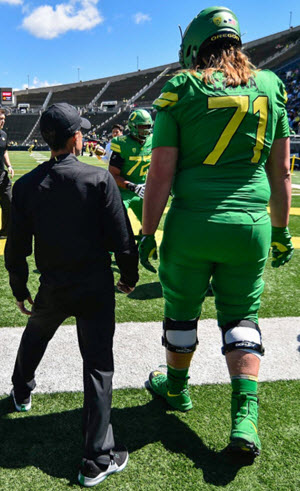
Alex Mirabal coaching Jacob Capra
Watch for first-down pass attempts. You don’t have to go crazy, but the more the Ducks called last year, the better the offense produced, as completions on first down do much to establish offensive momentum and confidence. As an example, in the Nebraska game on first down passes, Herbert was 11-of-12 for 137 yards and the Ducks had 42 points at halftime. In the second half, Taggart only called one, which Herbert completed for seven yards and the Ducks were shut out.
Play calling was still a concern after the Boise State debacle, but in the spring game there seemed to be a willingness to throw the ball more than last year: 44 pass attempts against 51 run attempts. There were 21 runs called on first-and-10, and 12 passes, which is not a big deal because it’s important to remember in a spring game that the play calling is not all just for the benefit of the offense. The defensive coaches want to see certain formations and plays to test their own players, so it’s not all on the offense to do whatever they want. Cristobal wants both sides of the ball to be physical and the offensive play calling was most likely intended to reinforce that maxim.
Who will run the ball? Royce Freeman will be missed, big time. Senior Tony Brooks-James is a better than average back, but he is not a pounder and does not have the body to stand up to a lot of carries during the game. Frosh C.J. Verdell looked to be more physical and has potential. Jaylon Redd is a wide receiver who is a threat on a fly sweep, Cyrus Habibi-Likio, a redshirt freshman, has talent; Darrian Felix showed speed last season as a freshman, but must get stronger; a real sleeper could be Troy Dye’s younger brother, Travis, who showed real toughness running the ball in a couple of goal line situations. Tough runs in the Dye family.
The new offensive backfield coach is Jim Mastro, who did an excellent job with the same kind of personnel at Washington State that he has inherited in Eugene. Look for the Ducks to run the ball like the Cougars the past few years, although more often and more effectively. Already, those backs that played last year for Oregon are showing more toughness than was observed in Las Vegas—Mastro was a good hire by Cristobal.
What’s the deal with the ‘Pistol? Mastro is also a master of the pistol formation, which has the one running back in a “tail back” position behind the quarterback in a shotgun position. Mastro made Chris Ault look good running the formation at Nevada when Colin Kaepernick was the quarterback. Some of the advantages of the pistol is that the back is deeper in the backfield and as a result, can see more running lanes sooner and gets the handoff running towards the line of scrimmage and not laterally, as with the spread formation. The running back is also in a better position to go to either side of the quarterback to provide pass protection. The formation forces the defense to be more balanced, thus more predictable.
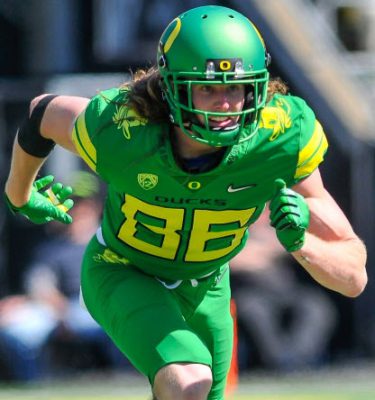
Brenden Schooler
With the spread, the running back is on either side of the quarterback, which makes it easier for the defense to align and anticipate certain plays. It is also difficult for the back to cross over in front of the quarterback to block on the other side of the formation on passes, which also forces the offensive line to make adjustments on the side of the formation where the back originally lined up. It is also more difficult for the spread back to see running lanes, being closer to the line of scrimmage and moving laterally, making cutbacks harder to see and execute.
Who’s going to be the receivers? Brenden Schooler has added muscle and shows solid instincts, much like Jeff Mehl, who made the switch from defensive back to wide receiver years ago. Schooler is not as talented as Mehl, who was good enough to make the NFL, but he is better than average, and with his work ethic, will get even better. It would be helpful for Jaylon Redd and Taj Griffin to rise to the level necessary to provide depth and the explosive speed they possess to this group.
Johnny Johnson III and Dillon Mitchell are speedy Pac-12 receivers who can make explosion plays and Daewood Davis showed he’s got that potential, too. It’s more that the receivers need to get their number called consistently for them to become the productive players they can be. It’s simple, the more balls thrown their way, the more you will see they are outstanding receivers. (Can you imagine having Herbert only throw two passes, both under 12 yards to Charles Nelson in ‘Vegas?).
How’s the defense going to do? You get what you pay for and defensive coordinator Jim Leavitt is earning every penny of the 1.7 million he’s getting to drag, lead, and inspire the Duck defense from the outhouse to the penthouse of the Pac-12. The defensive front is athletic with Justin Hollins and Jalen Jelks and beefy, with Frosh All American Jordon Scott and Gary Baker. Austin Faoliu is athletic and the most impressive newcomer has to be D.J. Johnson a 6-5, 256-pound freshman who transferred from Miami and may be eligible this season on a hardship request. Johnson looks like an NFL athlete already, and if he’s able to be on the field this fall, you’re looking at a defensive front the likes of which Duck fans have not seen.
Linebacker remains a weak spot in terms of depth. There is no one yet, ready to compliment the all conference Troy Dye, who has amazing instincts getting to the football before anyone else. Alongside Dye, Kaulana Apelu had a dream game, leading in tackles and intercepting a pass in his own end zone and returning it 103 yards for a score, almost making Justin Herbert dislocate his hips trying to track him down to prevent the score.
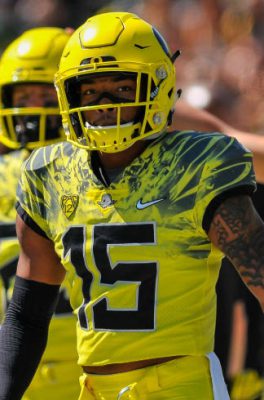
Deommodore Lenoir
Apelu is a great favorite with players and coaches, but when a physical team decides to run right at him, his 205 pounds do not match up well; the Ducks need to get a bigger, stronger presence next to Dye so he is not double teamed all game. One wonders if there has been thought of having Apelu play outside, either as a safety or outside linebacker, where he wouldn’t have to contend with as many monster offensive linemen.
More linebacking talent will make its presence known as the season goes along as La’Mar Winston, Jr, and Keith Simms will shine at outside linebacker and Isaac Slade-Matautia may be the bigger presence to play alongside Troy Dye.
How good will the secondary be? The Ducks have a senior safety in Mattrell McGraw and a sophomore, Brady Breeze, who is a good football player with outstanding instincts on both run and pass. Ugo Amadi will be worth his weight in gold as the senior has extensive experience at corner and safety; he will be needed for his leadership and savvy to bolster two sophomore corners who were torched often last year: Thomas Graham Jr. and Deommodore Lenoir. Getting torched as a freshman is nothing to be ashamed of—several NFL Ducks went through the same thing as freshmen. Pass defense begins at the line of scrimmage and a great pass rush will make these young defensive backs even better, faster.
Some experience in JC transfer Haki Woods will help the corner position as will frosh Verone McKinley III, but six corners on defense is just like only three quarterbacks on offense—to thin for the big time.
What about the kicking game? Punting despite swirling winds, Adam Stack averaged 42 yards per kick and Blake Maimone had a 47-yarder. The Duck coaching staff was very ambitious in getting as many kicking game repetitions as they could in a limited game with some players playing nearly every down on offense or defense. It appears Cristobal has put an emphasis on the return game, both kickoff and punt returns, which would be a positive change from last season.
One thing for sure, the Ducks won’t get as many touchbacks on kickoffs as they had last year with Aidan Schneider, who was a conference leader. It will be interesting to see how this will shake out with the new kickoff return rule that allows any kickoff that is fair caught between the 25-yard line and goal line to be put into play at the 25-yard line; not where the ball was caught, as is the rule for punt fair catches. If the Ducks aren’t careful, teams will eschew the fair catch, knowing they have a good chance of returning the ball past the 25-yard line because of a short kickoff.
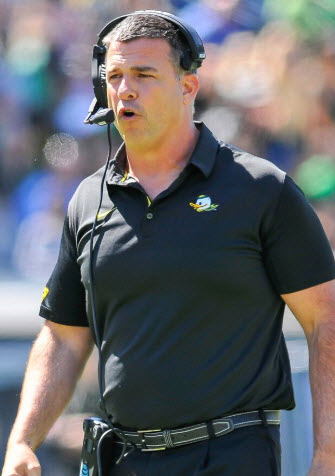
Mario Cristobal
Will the Ducks still lead the country in penalties? There were nine penalties in the game; not too many compared to last year (so that has to be progress), but the referees were not putting the same amount of scrutiny as they seem to do every game during the regular season. Cristobal pointed out several times during the spring practice season that the Ducks were taking too many penalties.
He does have officials at practices calling them and then going over those situations with players at subsequent film sessions, which is not dealing with them immediately as they happen during practice. Over time, this could be as good of an approach as anything else outside of using electric cattle prods on the practice field. Still, Chip Kelly‘s observation that you can “expect in games what you accept on the practice field,” for penalties still resounds; it will be interesting to see if the flood of yellow flags will diminish this coming season.
Things are different this year and with the strong leadership and sense of discipline that Cristobal displays on and off the field, the Ducks will cut down their penalties. There is a feeling that the Oregon football program has become more thoughtful and mature, from both coaches and players; and it is beginning to show.
The Ducks are on the right track. They are tougher, more resolute and have more character than last year’s team. Willie Taggart got it all started, but Cristobal and his staff have taken it to a new level. However, it’s a lot easier when it’s against yourself in the spring because some side of Oregon is going to win no matter what. The Ducks should be 3-0 when Stanford comes to Autzen in the fall. Right now, the Cardinal’s offense is mostly Brice Love, and if the defense can hold him in check, the Ducks will have a great chance to win a game against a Northern Division contender. This will be the test of whether all the tough talk and resolve is real and can hold up to competitive pressure.
I see the Ducks as a middle-of-the-conference team right now. With great quarterback play, continued progress on defense, and luck with injuries, Oregon could make the jump to contender. Unfortunately, it’s not like in the past when it seemed easy. No one fears the Ducks anymore—they will have to earn their victories by making fewer mistakes and taking fewer penalties against a bunch of Pac-12 teams that are attempting to climb the same ladder Oregon knew so well only three seasons ago when their mantra was “win the day.”
Ken Woody
Eugene, Oregon Top Photo by Kevin Cline
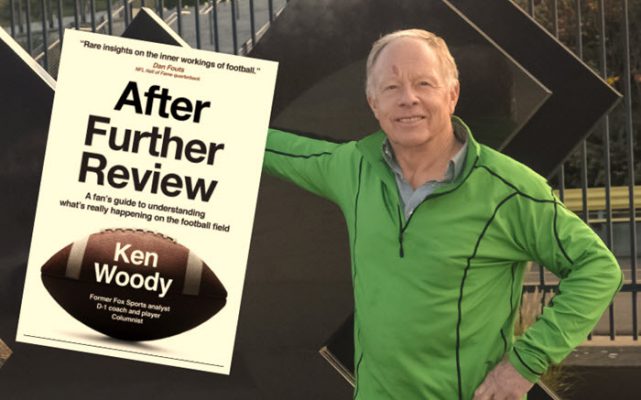
You can find Coach Woody’s book at Amazon.Com, UO Bookstore and Michael”s Fine Books.
Related Articles:
“I learned football working under many great coaches, among them Len Casanova, Jerry Frei, John Robinson, Bruce Snyder, George Seifert,and Ron Stratten at the University of Oregon, Jim Owens at the University of Washington and Jim Walden at Washington State University. Most of my coaching experience was on the offensive side of the ball with quarterbacks, receivers and kickers although as a head coach I coached defensive backs, linebackers and offensive line.
I achieved my first goal of being the youngest head coach in college football at the age of 26 and throughout my career in coaching and outside of it, as a journalist and broadcaster, have experienced how exciting and gratifying it is teaching the game to others.”

